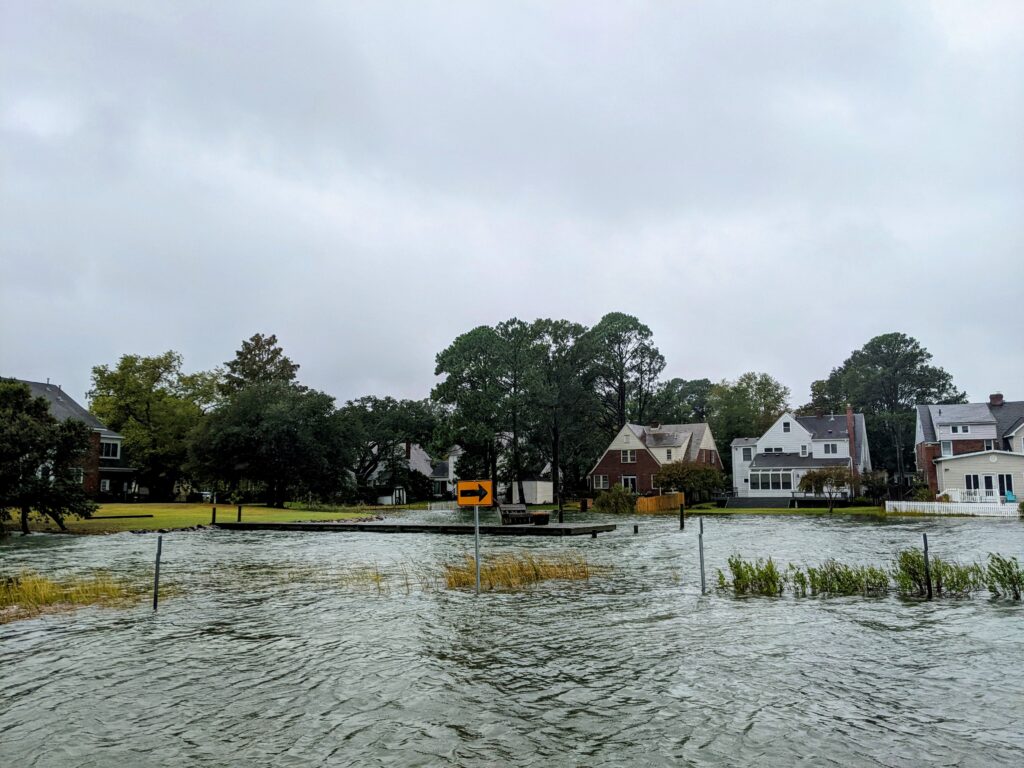Flooding in Norfolk in 2022. (Courtesy of Jim Morrison)
September is National Preparedness Month and the Virginia Department of Health is encouraging residents to get ready as the state enters into peak storm season.
“Be prepared,” said Bob Mauskapf, VDH director of the office of emergency preparedness, “for anything that you can think of that you would be without.”
The Virginia Department of Health is part of the state’s Virginia Emergency Support Team, or VEST, responsible for monitoring health impacts from mold showing up in flooded homes, the transfer of diseases through mosquitoes that congregate near collections of water and resulting hospital surges, and more. The Virginia Department of Emergency Management spearheads the team, which includes several other state agencies.
Earlier this year, North America switched from its dryer El Niño season into a wetter La Niña one, which happens every two to seven years. The change prompted the National Oceanic and Atmospheric Administration to predict there could be an increase in damaging named storms this year.
Millions of people were left without power in Texas this summer and at least three died after encountering Hurricane Beryl, the second, and perhaps most devasting, storm of this season. So far this year, Virginia has only issued a state of emergency for Tropical Storm Debby, the fourth storm of the season. Debby didn’t hit Virginia as hard as North Carolina, but preliminary findings confirmed tornado touchdowns in Glendie and Willisville, where winds were estimated to have reached 90 and 100 miles per hour, respectively.
“(Debby) was a grazing blow to us,” said Mauskapf, adding the storm season that runs until Nov. 30 “has not come to fruition.” But Virginia’s “highest incidence of Tropical Storm Activity in the area is usually October and early November. We’re entering into, if you will, the height of the Atlantic basin hurricane season,” he said.
Last week, Virginia braced for increased rain from Tropical Cyclone 8, a storm that typically moves in a circular pattern, unlike a derecho that runs in a straight line across a region, Mauskapf explained. Rain left the state sooner than expected, but water levels on the James River at Sewell Point in the Norfolk area reached as high as 4.87 feet, over a foot above ground level, on the eve of Sept. 17.
Winds as strong as 15 miles per hour from the northeast prevented water from receding, and so it lingered in that area. Weekend rain led to water levels in that same area rising over 5 feet Sunday night into Monday.
A screenshot of the National Weather Prediction Service’s reading of the James River at Sewell Point. (Courtesy of National Oceanic and Atmospheric Administration).
To prepare for the next bout of severe weather, the VDH is urging people to charge phones, keep backup power on hand, fill up gas tanks, safely store perishable food and, have a first aid kit. Sheltering options are available through one of VDH’s 35 local departments across the state and, in the event of emergencies, additional safe spaces are coordinated with universities.
The State Corporation Commission, which oversees that state’s insurance, is also urging residents to maintain updated policies, which can include “essential” flood insurance to repair damage to homes as government assistance can lag and the threat of flooding is expected to continue. It’s a familiar danger in Virginia, in the short and long term.
Located on the East Coast, Norfolk experiences the fastest rate of sea level rise in the country at 5.38 millimeters a year, which prompted the locality to propose a $2.6 million flood wall project. The state’s Coastal Resilience Master Plan, due for an update at the end of this year, states “the number of residents living in homes exposed to major coastal flooding is projected to grow from approximately 360,000 to 943,000, an increase of 160%.”
In Southwest Virginia, the towns of Hurley and Whitewood were pummeled with four to six inches of rain in 2021 and 2022, respectively, leading state emergency officials to explore ways of filling in gaps for post-storm relief. Scientists have said what happened in those smaller localities is a result of climate change: intenser, more frequent storms. Officials are now challenged with how to deploy resources in the face of increasingly violent weather.
“We don’t deal in climate change or forecasting. We do deal in the results of climate change,” said Mauskapf. “So we prepare our plans and our messaging, for these types of more frequent storms, higher temperatures, lower temperatures, whatever we may see. It’s the same threat.”
SUPPORT NEWS YOU TRUST.

